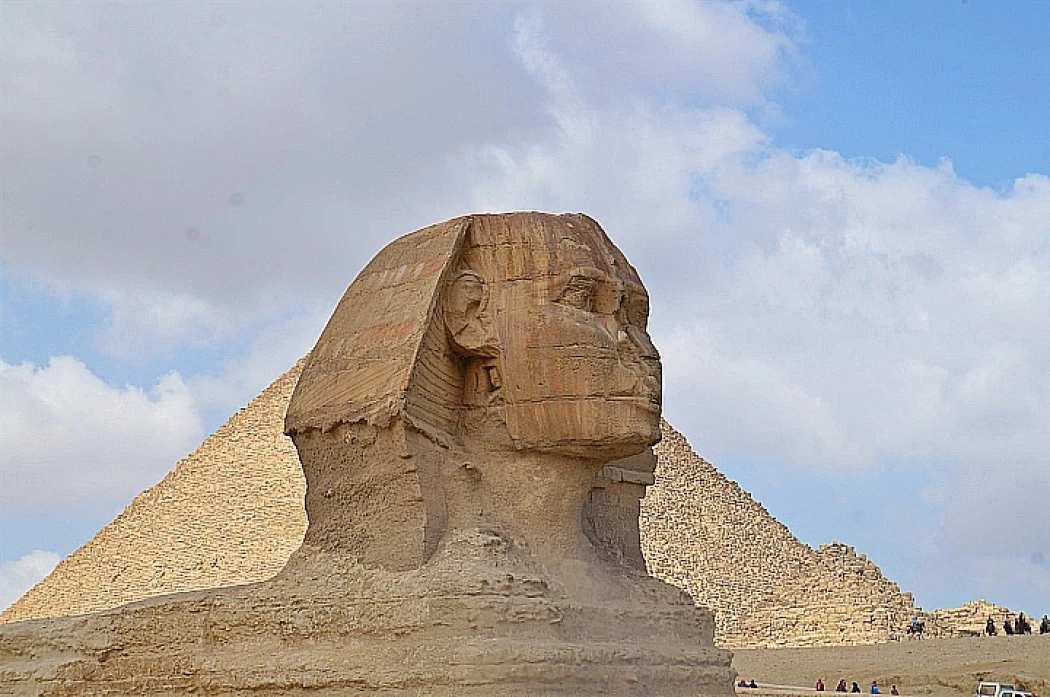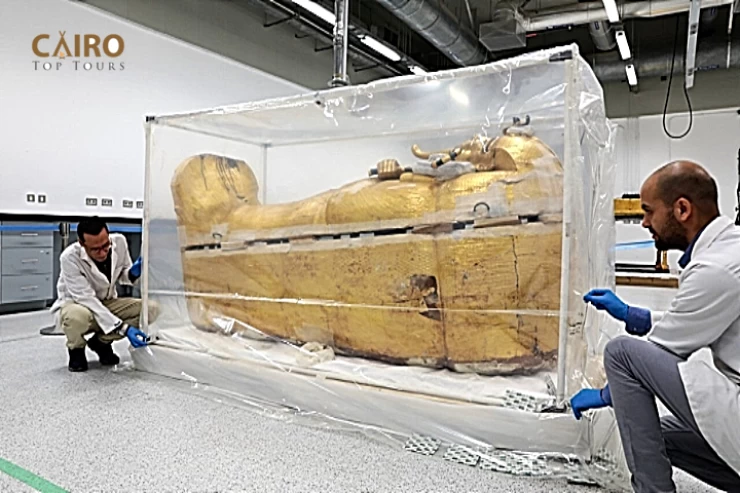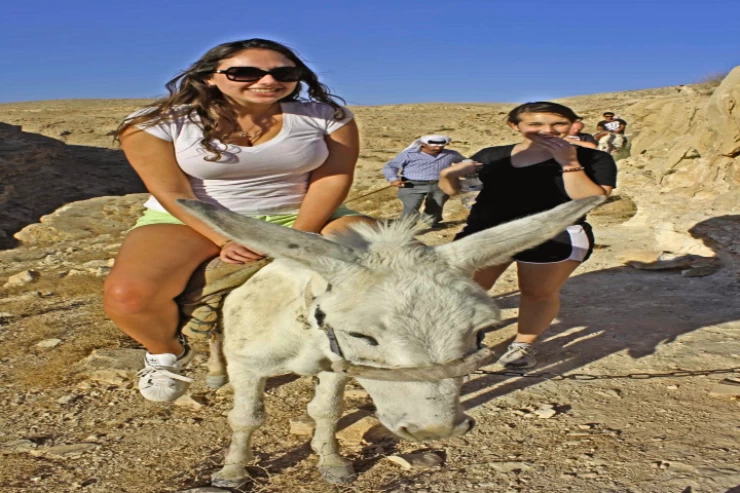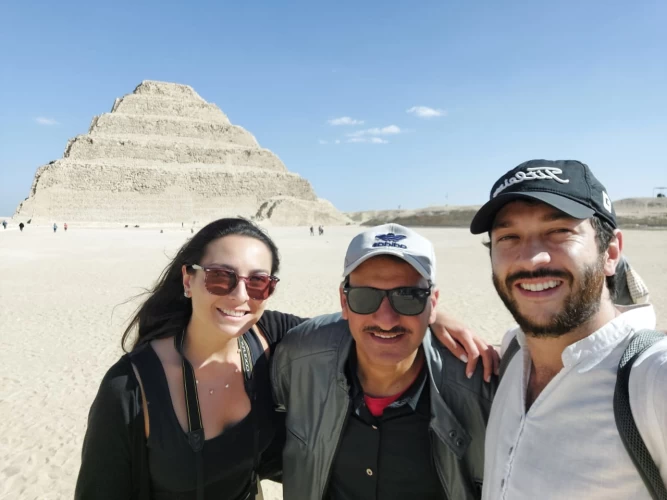
吉萨大狮身人面像的事实
不可否认,吉萨狮身人面像是全球最神秘却又最容易辨认的建筑之一。狮身人面像位于开罗附近的吉萨高原上,也可以从那里进入。狮身人面像是用石灰岩雕刻而成的巨大雕像,呈狮身人头状,据说是法老卡夫雷的雕像。这座迷人的建筑多年来一直是许多历史学家和考古学家(包括游客)感兴趣的话题,因为它的结构充满了神秘和古老的智慧。
大狮身人面像的起源和建造
大狮身人面像由法老卡夫雷于公元前 2500 年左右建造,是埃及最古老的纪念性建筑之一。它是由突出于吉萨高原的一整块石灰石基岩雕刻而成。狮身人面像高 20 米(66 英尺),长 73 米(240 英尺),可能是作为附近金字塔的象征性哨兵而建造的,法老就葬在附近的金字塔中。
狮身人面像的结构和位置仍然存在争议,因为有些人认为它是一个独立的纪念碑,而且还存在许多其他的神庙和通往卡夫雷金字塔的便道。支持这一理论的进一步解释是,狮身人面像的建造耗费了大量劳工的心血,而他们的武器只是非常粗糙的铜凿。虽然狮身人面像上可能布满了锯齿,而且年久失修,但作为古人的成就,这座建筑依然傲然屹立。
狮身人面像解码:象征意义
狮身人面像主要被认为是法老的两种重要品质的代表,即智慧和力量,它将人和狮子的形象结合在一起。狮身人面像的头部带有与法老相同的皇家头饰,可能代表了法老卡夫雷更为真实的形象,我们将通过这个形象看到他的力量和神性。根据一些埃及神话的记载,狮子是保护神,尤其是圣地的保护神;从这个意义上说,狮身人面像的狮身重申了其守护国王墓地的功能。
尤其是狮身人面像,多年来,它所代表的事物也发生了变化。一些研究人员认为,它描绘的可能是太阳神拉,拉在埃及人的信仰和意识形态中占有重要地位。狮身人面像的姿势直接朝向东方,而东方恰好是日出的方向,这可能会增加这种假设的可信度,因为拉神被描绘成每天乘船划过天空的神。
大金字塔之谜
经过一个世纪的理论研究,狮身人面像仍然是一个谜。其中一个最传统的问题是:谁为了什么目的建造了狮身人面像?几乎所有历史学家都认为它是由法老卡夫雷建造的。相反,其他一些理论则认为狮身人面像的建造年代非常久远,甚至可能早于金字塔。
此外,关于狮身人面像下的密室或洞穴的一些神话和传说也基本上没有得到证实。许多人认为,这些失落的空间(如果有的话)可能藏有古代卷轴或其他历史物品,可能有助于了解埃及一些被遗忘的历史。最近,地面穿透雷达和类似技术取得了突破性进展,人们试图解决这些问题,但迄今为止还没有发现任何确凿的证据。
另一个未解之谜与狮身人面像的鼻子有关,人们已经很久没有看到过它了。人们对它的命运有很多猜测,其中一种说法是它被拿破仑士兵的大炮炸掉了,另一种说法是马穆鲁克人只是把它当作练习用的假人。然而,现有的记录和拿破仑时代之前的图纸清楚地显示了狮身人面像的正面,而且没有鼻子,这表明损坏很可能发生在拿破仑时代之前。
狮身人面像和现代修复工作
在漫长的岁月中,大金字塔不断遭到侵蚀、破坏和污染,这也带来了许多旨在修复的活动。据记载,法老图特摩斯四世首次尝试修复狮身人面像,他梦见狮身人面像告诉他,如果他除去覆盖其下部的沙子,他就会成为国王。后来,图特摩斯四世在狮身人面像的两脚之间竖起一块石板,称为 “梦碑”,记录了这一事件。
近年来,保护该建筑的措施既包括遏制其侵蚀破坏,也包括为石质结构增加额外的支撑。不过,近年来,这些项目已将重点转移到解决开罗城市渗水和污染造成的退化问题上。保护主义者和考古学家仍在积极采取这些措施,试图找到更好的方法来确保这一古代奇迹在未来的文明中得到保护。
参观吉萨大狮身人面像
参观大狮身人面像的感受难以言表。它就在吉萨金字塔旁边,交通非常方便,在开罗的名胜古迹旅游团中也很常见。当人们站在狮身人面像旁时,很难不被这座古代雕塑的巨大规模所吸引。狮身人面像外的景色还能让人欣赏到金字塔的迷人景色,对于有兴趣用相机捕捉历史瞬间的人来说,这里是一个绝佳的去处。
狮身人面像是世界上最著名的建筑之一,每年都有数百万游客迫不及待地想一睹它平静而神秘的面容。从黎明到黄昏,狮身人面像在吉萨高原上彰显着自己的魅力,是一座记录古埃及文明的雕塑。
大狮身人面像的魅力难以言表。大狮身人面像就在吉萨金字塔旁边,交通十分便利,在开罗的名胜古迹游览中也很常见。当人们站在狮身人面像旁时,很难不被这座古代雕塑的巨大规模所吸引。狮身人面像外的景色还能让人欣赏到金字塔的迷人景色,是有兴趣用相机捕捉历史瞬间的游客的理想去处。
狮身人面像是世界上最知名的建筑之一,每年都有数百万游客迫不及待地想一睹它平静而神秘的面容。从黎明到黄昏,狮身人面像一直俯瞰着吉萨高原,这座雕塑记录着古埃及的文明。
大众文化中的狮身人面像
大众文化让狮身人面像成为一种标志。文学、电影和艺术作品中都有狮身人面像的身影。从古希腊诗歌到今天的电影,许多作品都受到了狮身人面像的影响和启发。狮身人面像怪兽保护着人们,并提出具有挑战性的问题。
因此,就其意义和重要性而言,吉萨大狮身人面像一直是与埃及历史相关的迷人标志。关于狮身人面像的构造、意义和象征,至今仍有各种解释。狮身人面像永远是沙地上的哨兵,是尼罗河畔文明繁荣的远古时代的遗迹。去狮身人面像不只是去看一个古代遗址,而是去面对自古以来困扰人类的最神秘、最难以解释的问题。
Undeniably among the most mysterious yet recognizable structures across the globe is the Great Sphinx of Giza. The Sphinx is located on the Giza Plateau near Cairo, from where it is also accessed. This sphinx is a huge statue sculptured from limestone and takes on the form of a lion with a human head believed to be that of Pharao Khafre. This captivating structure has been a topic of interest for many historians and archaeologists, including tourists, for many years, as its structure is enveloped with mystery and ancient wisdom.
The Genesis and Building of the Great Sphinx
The Great Sphinx was constructed by Pharaoh Khafre around 2500 B.C., making it one of the oldest monumental edifices in Egypt. It is formed from a single mass of limestone bedrock protruding from the Giza Plateau and carved intricately out of it. Twenty meters (66 feet) tall and 73 meters (240 feet) long, the Sphinx was probably built as a symbolic sentry to the nearby pyramids in which the pharaoh was entombed.
The structure and location of the Sphinx remain controversial, as some believe it is a standalone monument, and many other wannabe temples and causeways leading to the Pyramid of Khafre existed. Further explanation to support this theory suggests that the construction of the Sphinx took the toil of a great number of laborers armed only with copper chisels that were very crude. While it may be corniced and age-worn, this edifice stands proud as an accomplishment of the ancients.
Decoding the Sphinx: Symbolism and Significance
The Sphinx is mainly considered representative of the two vital qualities of the pharaoh, i.e., his intelligence and strength, by combining the man and a lion figure. The sphinx head bearing the same royal headdress as the pharaoh in question probably represents the more realistic likeness of the pharaoh Khafre, whose power and divine connection we'll see through this image. According to some Egyptian mythological accounts, lions served as protectors, particularly over sacred areas; in this sense, the lion body of the sphinx reiterates its function of guarding the king's burial ground.
The Sphinx in particular has changed over the years in the way that it typifies things. Some researchers believe that it could depict the sun god Ra, who held a fundamental position in the hierarchy of Egyptian beliefs and ideologies. The Sphinx has a direct pose towards the east, which happens to be the direction of the sunrise, which could add some credence to this assumption since Ra was depicted as the god who rode across the sky in a boat each day.
The Great Pyramid has its enigma
A century of theories and the Sphinx is still an enigma. One of the most conventional inquiries is: who constructed the Sphinx for what purpose? Almost all historians agree that it was built by Pharaoh Khafre. Some other theories, on the contrary, argue that the Sphinx was constructed in very remote times, perhaps even before the pyramids.
Also, some myths and beliefs about secret rooms or caves under the Sphinx remain largely unexamined. Many think that these lost spaces, if any, may house ancient scrolls or other historical items that may help in understanding some forgotten histories of Egypt. Lately, breakthroughs in ground-penetrating radar and similar technologies have tried addressing these, but so far nothing conclusive has been found.
Yet another unsolved puzzle relates to the Sphinx’s nose, which has not been seen for ages. Many speculations have been offered on its fate, including one that says it was blown off by the cannon of Napoleon’s soldiers and another that claims the Mamluks simply used it as a practice dummy. Yet there are existing records and drawings from before the era of Napoleon, which clearly show the Sphinx from the front and without the nose, suggesting that the damage had likely taken place far before that.
The Sphinx and modern restoration efforts
Through the ages, the Great Pyramid has been eroded, vandalized, and polluted, which has brought about many campaigns aimed at restoration. The Sphinx was first recorded to be attempted to be restored by Pharaoh Thutmose IV, where it was noted that he dreamt of the Sphinx informing him that he would be the king if he got rid of the sand that had covered its lower portions. Thutmose IV later erected a slab known as the Dream Stele to document this incident, which was placed in between the Sphinx’s feet.
In recent years, measures to protect the structure have involved both containment of its damage in terms of its erosion and adding extra support to the stone structure. However, in recent years, the projects have shifted focus to addressing the degradation caused by water penetration and pollution from the city of Cairo. Such measures are still active as conservationists and archaeologists try to find better ways of ensuring this ancient wonder's protection for the coming civilization.
The Great Sphinx’s visitation is something that is difficult to put into words. It can be found next to the Giza Pyramids, which makes logistics simple, and it is also common in tours around the historical sites in Cairo. As they stand next to the Sphinx, one can hardly escape the large scale of the ancient sculpture that exists in detail. The scenery outside the Sphinx also offers captivating views of the pyramids, making it a perfect place for people interested in capturing the moments in history with a camera.
The Sphinx, as one of the world’s most recognizable structures, records millions of visitors every year who can’t wait to look at its calm and enigmatic face. From dawn till dusk, the Sphinx exerts itself over the Giza Plateau, a sculpture chronicling the civilization of ancient Egypt.
The Great Sphinx in Popular Culture
Popular culture has made the sphinx an icon. Literature, film, and art have all featured the sphinx. Many works have been influenced and inspired by them, starting from ancient Greek poetry and ending in films today. Various cultures have also embraced the Sphinx Monster, who protects and asks challenging questions.
Therefore, fitting within the categories of significance and importance, the Great Sphinx of Giza has remained a fascinating emblem associated with the history of Egypt. There continue to be various explanations offered regarding its construction, significance, and symbolism. The Sphinx is forever a sentinel of the sands, a remnant of the long-gone age whose civilization thrived along the banks of the Nile River. Going to the Sphinx is not simply going to see an ancient site; it is going to confront the most mysterious and inexplicable issues that have beset mankind since time immemorial.Decoding the Sphinx:


















